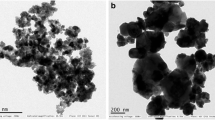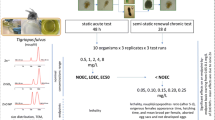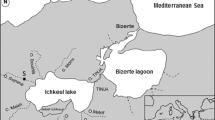Abstract
Excessive use of nickel oxide nanoparticles (NiO NPs) in various industrial and commercial products can lead to various negative effects in human and environmental health due to their possible discharge into the environment. Nerveless, information about their ecotoxicological effects on marine organisms are lacking. Copepods are good ecotoxicological models because of their high sensitivity to environmental stress and their key role in the marine food webs. In this study, 48 h acute tests were conducted on the marine planktonic copepod Centropages ponticus to assess lethal and sublethal toxicities of NiO NPs. The results revealed LC50 (48 h) of 4 mg/L for adult females. Aggregation and settling of NiO NPs were observed at concentrations ≥ 2 mg/L. Exposure to sublethal concentrations (≥ 0.02 mg/L for 48 h) had significant negative effects on reproductive success in C. ponticus. Egg production after 24 h and 48 h decreased by 32% and 46%, respectively at 0.02 mg/L and 70% and 82%, respectively, at 2 mg/L. Hatching success was reduced by 70% and 79% at 2 mg/L for eggs produced after 24 h and 48 h respectively. Antioxidant enzymatic activity increased significantly with NiO NP concentration and time, indicating that NiO NPs can cause oxidative stress in C. ponticus even under short-term exposure, while significant inhibition of acetylcholinesterase activity at 2 mg/L after 48 h suggests neurotoxic effects of NiO NPs.



Similar content being viewed by others
Data availability
Not applicable.
References
Abdel-Khalek AA, Kadry M, Hamed A, Marie MA (2015) Ecotoxicological impacts of zinc metal in comparison to its nanoparticles in Nile tilapia; Oreochromis niloticus. J Basic Appl Zool 72:113–125
Ada K, Turk M, Oguztuzun S, Kilic M, Demirel M, Tandogan N, Ersayar E, Latif O (2010) Cytotoxicity and apoptotic effects of nickel oxide nanoparticles in cultured HeLa cells. Folia Histochem Cytobiol 48:524–529
Ates M, Demir V, Arslan Z, Camas M, Celik F (2016) Toxicity of engineered nickel oxide and cobalt oxide nanoparticles to Artemia salina in seawater. Water Air Soil Pollut 227:70
Avila-Arias H, Loring F, Nies LF, Gray MB, Turco RF (2019) Impacts of molybdenum, nickel, and lithium oxide nanomaterials on soil activity and microbial community structure. Sci Total Environ 652:202–211
Bainy ACD, De Medeiros MHG, Di Mascio P, de Almeida EA (2006) In vivo effects of metals on the acetylcholinesterase activity of the Perna perna mussel’s digestive gland. Biotemas 19:35–39
Bradford MM (1976) A rapid and sensitive method for the quantitation of microgram quantities of protein utilizing the principle of protein-dye binding. Anal Biochem 72:248–254
Bianchi F, Acri F, Bernardi Aubry F, Berton A, Boldrin A, Camatti E, Cassin D, Comaschi A (2003) Can plankton communities be considered as bio-indicators of water quality in the Lagoon of Venice? Mar Bull Poll 46:964–971
Bonansea RI, Wunderlin DA, Amé MV (2016) Behavioral swimming effects and acetylcholinesterase activity changes in Jenynsia multidentata exposed to chlorpyrifos and cypermethrin individually and in mixtures. Ecotox and Environ Safe 129:311–319
Cailleaud K, Maillet G, Budzinski H, Souissi S, Forget JL (2007) Effects of salinity and temperature on the expression of enzymatic biomarkers in Eurytemora affinis (Calanoida, Copepoda). Comp Biochem Phys A 174:841–849
Cailleaud K, Budzinski H, Lardy S, Augagneur S, Barka S, Souissi S, Forget-Leray J (2011) Uptake and elimination, and effect of estrogen-like contaminants in estuarine copepods: an experimental study. Environ Sci Pollut Res 18:226–236
Capasso L, Camatini M, Gualtieri M (2014) Nickel oxide nanoparticles induce inflammation and genotoxic effect in lung epithelial cells. Toxicol Lett 226:28–34
Claiborne A (1985) Catalase activity. In: Greenwald RA (ed) CRC handbook of methods for oxygen radical research. CRC Press, Boca Raton, Florida, pp 283–284
Dasari S, Ganjayi MS, Oruganti L, Balaji H, Meriga B (2017) Glutathione s-transferases detoxify endogenous and exogenous toxic agents—mini review. J Dairy Vet Anim Res 5:157–159
Ellman GL, Courtney KD, Andres VJR, Feather-Stone RM (1961) A new and rapid colorimetric determination of acetylcholinesterase activity. Biochem Pharmacol 7:88–90
Mohammed EH (2014) Biochemical response of the cyclopoida copepod Apocyclops borneoensis exposed to nickel. Jordan J Biol Sci 7:41–47
Ensibi C, Pringault O, Hannaoui W, Yahia MND (2015) Effects of cadmium exposure on reproduction and survival of the planktonic copepod Centropages ponticus. J Marine Sci Res Dev 5:159
Ensibi C, Yahia MND (2017) Toxicity assessment of cadmium chloride on planktonic copepods Centropages ponticus using biochemical markers. Toxicol Rep 4:83–88
EPA U (2009) National water quality inventory: report to Congress. Environmental Protection Agency, Washington
Farkas J, Cappadona V, Olsen AJ, Hansen BH, Posch W, Ciesielski TM, Goodhead R, Wilflingseder D, Blatzer M, Altin D, Moger J, Booth AM, Jenssen BM (2020) Combined effects of exposure to engineered silver nanoparticles and the water-soluble fraction of crude oil in the marine copepod Calanus finmarchicus. Aquat Toxicol 277:105582
Ferreira G, Carvalho-Silva M, Gonçalves C, Silva J, Scaini G, Ghedim F, Deroza P, Zugno A, Pereira T, Oliveira G, Kist L, Bogo M, Schuck P, Ferreira G, Streck E (2012) L-Tyrosine administration increases acetylcholinesterase activity in rats. Neurochem Int 61:1370–1374
Fossi MC, Minutoli R, Guglielmo L (2001) Preliminary results of biomarker responses in zooplankton of brackish environments. Mar Pollut Bull 42:745–748
Forget LJ, Beliaeff B, Bocquené G (2003) Acetylcholinesterase activity in copepods (Tigriopus brevicornis) from the Vilaine River estuary, France, as a biomarker of neurotoxic contaminants. Aquat Toxicol 62:195–204
Geissen V, Mol H, Klumpp E, Umlauf G, Nadal M, Van der Ploeg M, Van de Zee SE, Ritsema CJ (2015) Emerging pollutants in the environment: a challenge for water resource management. Int Soil Water Conserv Res 3:57–65
Gomes SLL, Carlos P, Roca CP, Scott-Fordsmand JJ, Amorim MJ (2019) High-throughput transcriptomics: insights into the pathways involved in (nano) nickel toxicity in a key invertebrate test species. Environ Pollut 245:131–140
Gong N, Shao K, Feng W, Lin Z, Liang C, Sun Y (2011) Biotoxicity of nickel oxide nanoparticles and bio-remediation by microalgae Chlorella vulgaris. Chemosphere 83:510–516
Gong N, Shao K, Li G, Sun Y (2016) Acute and chronic toxicity of nickel oxide nanoparticles to Daphnia magna: the influence of algal enrichment. Nanoimpact 3-4:104–109
Gong N, Shao K, Che C, Sun Y (2019) Stability of nickel oxide nanoparticles and its influence on toxicity to marine algae Chlorella vulgaris. Mar Pollut Bull 149:110532
Habig WH, Pabst MJ, Jakoby WB (1974) Glutathione S-transferases. The first enzymatic step in mercapturic acid formation. J Biol Chem 249:7130–7139
Han ZX, Zhang M, Lv CX (2012) Bioaccumulation and toxicity of NiO nanoparticles in Gracilaria lemaneiformis. Adv Mater Res 518:942–945
Hanna SK, Miller RJ, Zhou D, Keller AA, Lenihan HS (2013) Accumulation and toxicity of metal oxide nanoparticles in a soft-sediment estuarine amphipod. Aquat Toxicol 142-143:441–446
Hussain MB, Laabir M, Daly Yahia MN (2020) A novel index based on planktonic copepod reproductive traits as a tool for marine ecotoxicology studies. Sci Total Environ 727:138621
Ighodaro OM, Akinloye OA (2018) First line defence antioxidants-superoxide dismutase (SOD), catalase (CAT) and glutathione peroxidase (GPX): their fundamental role in the entire antioxidant defence grid. Alexandria J Med 54:287–293
International Organization for Standardzation (1999 revised 2015) Water quality—determination of acute lethal toxicity to marine copepods (Copepoda, Crustacea). In: Draft International Standard ISO/DIS 14669. ISO, Genève
Jayalakshmi T, Santhanam P (2019) A microcosm study on the impact of acidification on feeding, survival, nauplii production rate, post-embryonic development and nutritional composition of marine copepod. In: Santhanam P, Begum A, Pachiappan P (eds) . Basic and Applied Zooplankton Biology, Singapore, pp 395–428
Kanold JM, Wang J, Brümmer F, Siller L (2016) Metallic nickel nanoparticles and their effect on the embryonic development of the sea urchin Paracentrotus lividus. Environ Pollut 212:224–229
Khan I, Saeed K, Khan I (2019) Nanoparticles: properties, applications and toxicities. Arab J Chem 12:908–931
Kim BM, Rhee JS, Jeong CB, Seo JS, Park GS, Lee YM, Lee JS (2014) Heavy metals induce oxidative stress and trigger oxidative stress-mediated heat shock protein (hsp) modulation in the intertidal copepod Tigriopus japonicus. Comp Biochem Physiol C Toxicol Pharmacol 166:65–74
Kovrižnych JA, Sotníková R, Zeljenková D, Rollerová E, Szabová E, Wimmerová S (2013) Acute toxicity of 31 different nanoparticles to zebrafish (Danio rerio) tested in adulthood and in early life stages—comparative study. Interdiscip Toxicol 6:67–73
Kovrižnych AJ, Sotníková R, Zeljenková D, Rollerová E, Szabová E (2014) Long-term (30 days) toxicity of NiO nanoparticles for adult zebrafish Danio rerio. Interdiscip Toxicol 7:23–26
Lauer MM, Bianchini A (2010) Chronic copper toxicity in the estuarine copepod Acartia tonsa at different salinities. Environ Toxicol Chem 29:2297–2303
Mahmoud AM, Ibrahim FA, Shaban SA, Youssef NA (2015) Adsorption of heavy metal ion from aqueous solution by nickel oxide nano catalyst prepared by different methods. Egypt J Pet 24:27–35
Manke A, Wang L, Rojanasakul Y (2013) Mechanisms of nanoparticle-induced oxidative stress and toxicity. Biomed Res Int 1:942916
Matouke MM, Mustapha M (2018) Bioaccumulation and physiological effects of copepods sp. (Eucyclop sp.) fed Chlorella ellipsoides exposed to titanium dioxide (TiO2) nanoparticles and lead (Pb 2+). Aquat Toxicol 198:30–39
Mazzocchi MG, Paffenhöfer GA (1999) Swimming and feeding behavior of the planktonic copepod Clausocalanus furcatus. J Plankton Res 21:1501–1518
McCord JM, Fridovich I (1969) Superoxide dismutase: an enzymic function for erythrocuprein (hemocuprein). J Biol Chem 244:6049–6055
Miglietta ML, Rametta G, Di Francia G, Manzo S, Rocco A, Carotenuto R, De Luca PF, Buono S (2015) Characterization of nanoparticles in seawater for toxicity assessment towards aquatic organisms. Lect Notes Electr Eng 91:425–429
Nogueira V, Lopes I, Rocha-Santos TAP, Rasteiro MG, Abrantes N, Gonçalves F, Soares AMVM, Duarte AC, Pereira R (2015) Assessing the ecotoxicity of metal nano-oxides with potential for wastewater treatment. Environ Sci Pollut Res 22:13212–13224
Noss C, Dabrunz A, Rosenfeldt RR, Lorke A, Schulz R (2013) Three-dimensional analysis of the swimming behavior of Daphnia magna exposed to nanosized titanium dioxide.18. PLoS One 8:e80960
Oukarroum A, Barhoumi L, Samadani M, Dewez D (2015) Toxic effects of nickel oxide bulk and nanoparticles on the aquatic plant Lemna gibba L. Biomed Res Int 2015:1–7
Oukarroum A, Zaidi W, Samadani M, Dewez D (2017) Toxicity of nickel oxide nanoparticles on a freshwater green algal strain of Chlorella vulgaris. Biomed Res Int 2017:1–8
Parlapiano I, Biandolino F, Russo V, Manfra L, Rotini A, Migliore L, Prato E (2017) Chronic toxicity of ZnO nanoparticles: effects on survival and reproductive traits of the marine copepod Tigriopus fulvus. PeerJ Preprints 5:e3276v1
Pinho GLL, Mora da Rosa A, Macial EF, Bianchini A, Yunes JS, Proença LAO, Monserrat JM (2005) Antioxidant responses and oxidative stress after microcystin exposure in the hepatopancreas of an estuarine crab species. Ecotox Environ Safe 61:353–360
Prione LP, Olchanheski LR, Tullio LD, Santo BCE, Reche PM, Martins PF, Carvalho G, Demiate IM, Pileggi SAV, Dourado MN, Prestes RA, Sadowsky MJ, Azevedo RA, Pileggi M (2016) GST activity and membrane lipid saturation prevents mesotrione-induced cellular damage in Pantoea ananatis. ABM Express 6:70
Ren Q, Zhao R, Wang C, Li S, Zhang T, Ren Z, Yang M, Pan H, Xu S, Zhu J, Wang X (2017) The role of ache in swimming behavior of Daphnia magna: correlation analysis of both parameters affected by deltamethrin and methomyl exposure. J Toxicol 2017:11
Salama AM, Helmy EA, Abd El-ghany TM, Ganash M (2020) Nickel oxide nanoparticles application for enhancing biogas production using certain wastewater bacteria and aquatic macrophytes biomass. Waste Biomass Valor 1-12
Soler ET, Del Rio JG, Vives F (1988) Morphological and taxonomical revision of Centropages ponticus Karavaev, 1895 (Copepoda, Calanoida). Crustaceana 55:129–146
Sousa CA, Soares HMVM, Soares EV (2018a) Nickel oxide (NiO) nanoparticles induce loss of cell viability in yeast mediated by oxidative stress. Chem Res Toxicol 31:658–665
Sousa AC, Soares HMVM, Soares VE (2018b) Toxic effects of nickel oxide (NiO) nanoparticles on the freshwater alga Pseudokirchneriella subcapitata. Aquat Toxicol 204:80–90
Sukhanova A, Bozrova S, Sokolov P, Berestovoy M, Karaulov A, Nabiev I (2018) Dependence of nanoparticle toxicity on their physical and chemical properties. Nanoscale Res Lett 13:44
Tadik M, Nikolic D, Panjan M, Blake GM (2015) Magnetic properties of NiO (nickel oxide) nanoparticles: blocking temperature and neel temperature. J Alloys Compd 647:1061–1068
Wang Z, Zhao J, Li F, Gao D, Xing B (2009) Adsorption and inhibition of acetylcholinesterase by different nanoparticles. Chemosphere 77:67–73
Wang H, Burgess RM, Cantwell MG, Portis LM, Perron MM, Wu F, Ho KT (2014) Stability and aggregation of silver and titanium dioxide nanoparticles in seawater: role of salinity and dissolved organic carbon. Environ Toxicol Chem 33(5):1023–1029
Wiesner MR, Lowry GV, Alvarez P, Dionysiou D, Biswas P (2006) Assessing the risks of manufactured nanomaterials. Environ Sci Technol 40:4336–4345
Wong SWY, Zhou GJ, Leung PTY, Han J, Lee JS, Kwok KWH, Leung KMY (2020) Sunscreens containing zinc oxide nanoparticles can trigger oxidative stress and toxicity to the marine copepod Tigriopus japonicus. Mar Pollut Bull 154:111078
Zhang M, Yang J, Cai Z, Feng Y, Wang Y, Zhang D, Pan X (2019) Detection of engineered nanoparticles in aquatic environment: 2 state-of-art and challenges in enrichment, separation and analysis. Environ Sci Nano 3:1–78
Zhou C, Vitiellol V, Casals E, Puntes VF, Iamunno F, Pellegrini D, Wu C, Benvenuto G, Buttino I (2016) Toxicity of nickel in the marine calanoid copepod Acartia tonsa: nickel chloride versus nanoparticles. Aquat Toxicol 170:1–12
Zhou C, Carotenuto Y, Vitiello V, Wu C, Zhang J, Buttino I (2018) De novo transcriptome assembly and differential gene expression analysis of the Calanoid copepod Acartia Tonsa exposed to nickel nanoparticles. Chemosphere 209:163–172
Acknowledgments
The authors would like to thank the members of the Laboratory for Environmental Biomonitoring (Faculty of Sciences of Bizerte; Tunisia), especially Professor Mohamed Dalleli and Ms. Wiem Saidani, for their help in biomarker analysis. We are also grateful to the Institute of Fishing and Aquaculture (ISPA) (Bizerte, Tunisia), especially Professor Mohammed Chalghaf, for algae supply. Special thanks to Professor Abdelhak Othmani for providing nanoparticles. We would like to thank Mary McAfee for the English correction and improvement.
Funding
This research is part of the PhD work of Ms. Emna Djebbi, which is co-funded by the University of Carthage (Bourse d’Alternance) and IRD-Tunisia (Institut de Recherche pour le Développement). The funders had no role in the study design, analysis or interpretation of the data, writing the manuscript, or the decision to submit the paper for publication.
Author information
Authors and Affiliations
Contributions
Emna Djebbi and Mohamed Néjib Daly Yahia contributed to the conception and design of work. Emna Djebbi and Delphine Bonnet contributed to data acquisition and analysis. The first draft of the manuscript was written by Emna Djebbi (PhD student). Delphine Bonnet commented and revised previous versions of the manuscript. Delphine Bonnet, Olivier Pringault, Khaoula Tlili, and Mohamed Néjib Daly Yahia critically revised and approved the manuscript before submission.
Corresponding author
Ethics declarations
Competing interests
The authors declare that they have no competing interests.
Ethics approval and consent to participate
Not applicable.
Consent to publish
Not applicable.
Additional information
Responsible Editor: Philippe Garrigues
Publisher’s note
Springer Nature remains neutral with regard to jurisdictional claims in published maps and institutional affiliations.
Rights and permissions
About this article
Cite this article
Djebbi, E., Bonnet, D., Pringault, O. et al. Effects of nickel oxide nanoparticles on survival, reproduction, and oxidative stress biomarkers in the marine calanoid copepod Centropages ponticus under short-term exposure. Environ Sci Pollut Res 28, 21978–21990 (2021). https://doi.org/10.1007/s11356-020-11781-1
Received:
Accepted:
Published:
Issue Date:
DOI: https://doi.org/10.1007/s11356-020-11781-1




